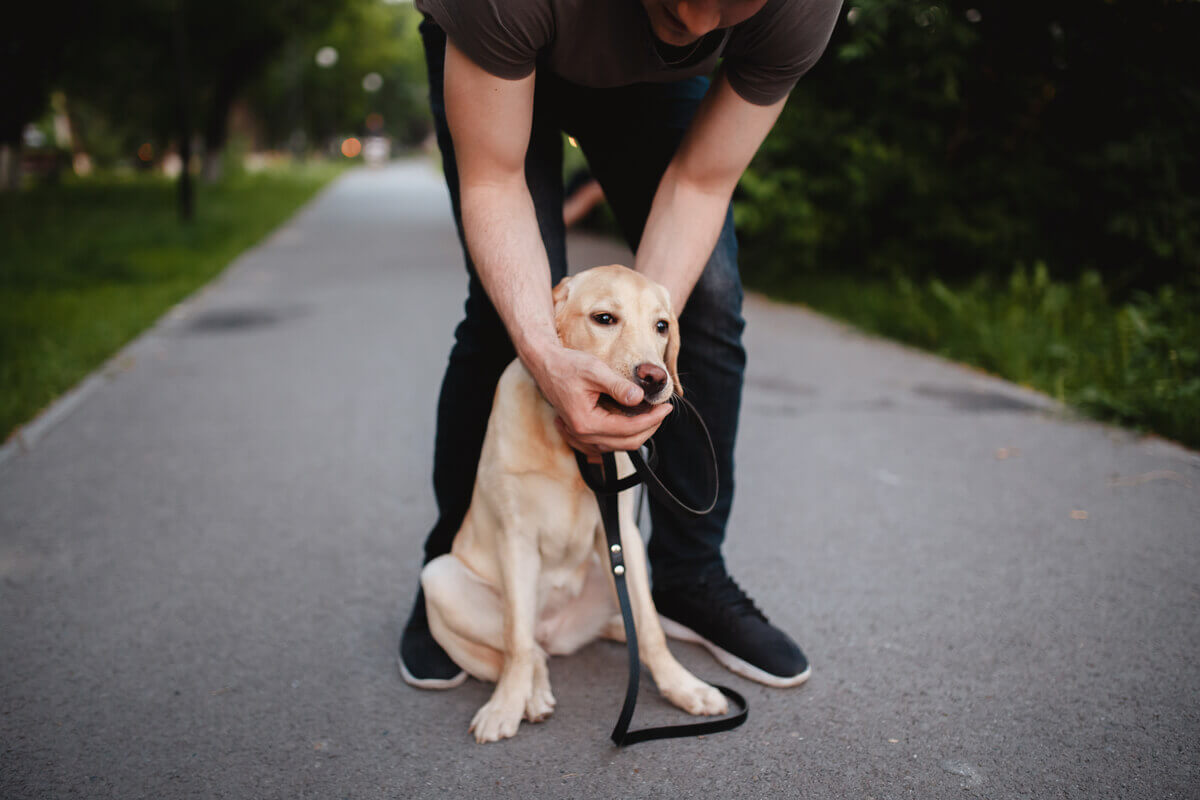7 Causes of Suffocation in Dogs


Reviewed and approved by the biologist Samuel Sanchez
Many dog owners have seen their dogs choking on an object or on food. Suffocation in dogs can occur due to multiple reasons. In this situation, the owner should never lose their cool.
This is because your dog will perceive your nerves, which will worsen their anxiety. If you take it easy and follow a few steps, you’ll be able to help your dog. Below, we’ll tell you about the most common causes of suffocation in dogs. Be vigilant!
1. Toys and food
Dogs generally bite off more than they can chew. Simply keep an eye out for any object that your dog puts in its mouth. You’ll see it get smaller while your dog chews, until it fits in its throat. But if the object or food is too big, choking occurs.
Bones, shoes, or wood can be deadly if you don’t closely monitor your dog when it’s playing with them.
Similarly, food scraps such as bones, seeds, or very big solid pieces can also get stuck in your dog’s windpipe and partially or completely block its air passage. The solution is to supervise your pet while it plays and carefully take away the toy or bone once it’s small enough to fit completely in its mouth.

2. Drowning
An owner shouldn’t overestimate their dog’s swimming abilities nor leave it alone in a lake or pool. If your dog is far from the shore and is physically exhausted, water can enter its airways and put its life at risk.
To avoid the first scenario, it’s a good idea to install ramps in your pool and help your dog when it gets tired of swimming.
3. Smoke inhalation or carbon monoxide poisoning
Similarly, smoke inhalation due to a fire or carbon monoxide poisoning in unventilated places, such as a garage or parking lot, cause suffocation.
4. Heatwaves
Perhaps you’ve seen a dog locked in its owner’s car with its tongue hanging outside its mouth, desperate to get out. This difficult situation puts the dog’s life at risk, especially when it’s hot. This is because it’ll have a harder time breathing, as no air is circulating through the vehicle.
5. Falls
Another cause of suffocation in dogs can be a fall, especially if it injures the thorax, neck, or chest. Factors such as the animal’s age and weight will determine the severity of the injury, as the bones and cartilage of the neck become more flexible over time and, thus, more likely to fracture.
6. Diseases
Some medical conditions make your pet more likely to suffer suffocation. Tracheobronchitis, better known as kennel cough, is one of the best known. It spreads from one dog to another through phlegm or sneezing. This condition causes a dog to clear its throat frequently. The good news is that it can be treated.
Juvenile pyoderma is another disease that affects puppies. It causes a swelling of the throat and lymph nodes.
7. Unsuitable collars
Common ornaments like collars can be dangerous to dogs if they’re too tight. You should check your dog’s collar often, especially when it’s growing, as this will prevent it from suffocating on it. One trick is to insert two fingers between your dog’s neck and the collar to create more space.
How to prevent suffocation in dogs
There are some methods that can help prevent cases of suffocation in dogs. However, the best recommendation is to always keep a close eye on your pet, regardless of their age or how much you trust it. Here are two important methods that could save your dog’s life in extreme situations.
- The Heimlich maneuver. Your posture will depend on your dog’s size. If it’s small, hold it on your lap face down, with its back against your chest. Then, place a fist under the breastbone and your other hand on top of your fist. Squeeze your dog’s abdomen or hit its back with the palm of your hand four times.
- Cardiopulmonary resuscitation (CPR). If the object doesn’t come out, you should lay your dog on the floor on its right side. If it’s a puppy, put an open hand on each side of its chest. However, if it’s big, put both hands on the thorax, one on top of the other. Finally, do 60 compressions per minute and two rescue breaths every 30 compressions until your dog starts breathing again.

These two methods are for emergency situations. You’ll need to seek professional help at a veterinary clinic if you can’t get your dog to breathe. Remember that it’s important to pay close attention to the toys your dog usually plays with and always be prepared to administer first aid if necessary.
Many dog owners have seen their dogs choking on an object or on food. Suffocation in dogs can occur due to multiple reasons. In this situation, the owner should never lose their cool.
This is because your dog will perceive your nerves, which will worsen their anxiety. If you take it easy and follow a few steps, you’ll be able to help your dog. Below, we’ll tell you about the most common causes of suffocation in dogs. Be vigilant!
1. Toys and food
Dogs generally bite off more than they can chew. Simply keep an eye out for any object that your dog puts in its mouth. You’ll see it get smaller while your dog chews, until it fits in its throat. But if the object or food is too big, choking occurs.
Bones, shoes, or wood can be deadly if you don’t closely monitor your dog when it’s playing with them.
Similarly, food scraps such as bones, seeds, or very big solid pieces can also get stuck in your dog’s windpipe and partially or completely block its air passage. The solution is to supervise your pet while it plays and carefully take away the toy or bone once it’s small enough to fit completely in its mouth.

2. Drowning
An owner shouldn’t overestimate their dog’s swimming abilities nor leave it alone in a lake or pool. If your dog is far from the shore and is physically exhausted, water can enter its airways and put its life at risk.
To avoid the first scenario, it’s a good idea to install ramps in your pool and help your dog when it gets tired of swimming.
3. Smoke inhalation or carbon monoxide poisoning
Similarly, smoke inhalation due to a fire or carbon monoxide poisoning in unventilated places, such as a garage or parking lot, cause suffocation.
4. Heatwaves
Perhaps you’ve seen a dog locked in its owner’s car with its tongue hanging outside its mouth, desperate to get out. This difficult situation puts the dog’s life at risk, especially when it’s hot. This is because it’ll have a harder time breathing, as no air is circulating through the vehicle.
5. Falls
Another cause of suffocation in dogs can be a fall, especially if it injures the thorax, neck, or chest. Factors such as the animal’s age and weight will determine the severity of the injury, as the bones and cartilage of the neck become more flexible over time and, thus, more likely to fracture.
6. Diseases
Some medical conditions make your pet more likely to suffer suffocation. Tracheobronchitis, better known as kennel cough, is one of the best known. It spreads from one dog to another through phlegm or sneezing. This condition causes a dog to clear its throat frequently. The good news is that it can be treated.
Juvenile pyoderma is another disease that affects puppies. It causes a swelling of the throat and lymph nodes.
7. Unsuitable collars
Common ornaments like collars can be dangerous to dogs if they’re too tight. You should check your dog’s collar often, especially when it’s growing, as this will prevent it from suffocating on it. One trick is to insert two fingers between your dog’s neck and the collar to create more space.
How to prevent suffocation in dogs
There are some methods that can help prevent cases of suffocation in dogs. However, the best recommendation is to always keep a close eye on your pet, regardless of their age or how much you trust it. Here are two important methods that could save your dog’s life in extreme situations.
- The Heimlich maneuver. Your posture will depend on your dog’s size. If it’s small, hold it on your lap face down, with its back against your chest. Then, place a fist under the breastbone and your other hand on top of your fist. Squeeze your dog’s abdomen or hit its back with the palm of your hand four times.
- Cardiopulmonary resuscitation (CPR). If the object doesn’t come out, you should lay your dog on the floor on its right side. If it’s a puppy, put an open hand on each side of its chest. However, if it’s big, put both hands on the thorax, one on top of the other. Finally, do 60 compressions per minute and two rescue breaths every 30 compressions until your dog starts breathing again.

These two methods are for emergency situations. You’ll need to seek professional help at a veterinary clinic if you can’t get your dog to breathe. Remember that it’s important to pay close attention to the toys your dog usually plays with and always be prepared to administer first aid if necessary.
All cited sources were thoroughly reviewed by our team to ensure their quality, reliability, currency, and validity. The bibliography of this article was considered reliable and of academic or scientific accuracy.
- RCP para gatos y perros. Recogido el 22 de febrero de 2021 de https://depts.washington.edu/learncpr/spanish/cat&dog.html
-
Monóxido de carbono. Recogido el 22 de febrero de 2021 de https://espanol.epa.gov/cai/monoxido-de-carbono
This text is provided for informational purposes only and does not replace consultation with a professional. If in doubt, consult your specialist.








